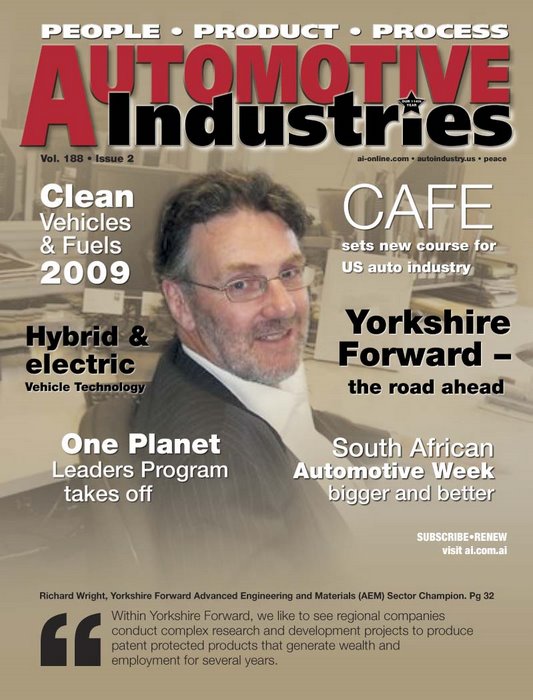
INTERVIEW – The United Kingdom, like the rest of Europe and indeed the world, is trying to revitalize its industry. One way it is achieving this goal, is by setting up regional development agencies – there are nine such agencies in England alone. One of them is Yorkshire Forward which is the regional development agency for the Yorkshire and Humberside region.
Yorkshire Forward’s mission is to promote the region as a better place to live, work and invest in. The area’s Regional Economic Strategy or RES, is focused on growing the current £87 billion economy. Yorkshire Forward has outlined six main objectives – increasing business start-ups, making existing businesses more competitive, ensuring a strong regional bank of talent, increasing employment opportunities, improving transport and infrastructure facilities and making cities, towns and rural communities attractive to live in. The RES time frame is ten years of which five years have already passed.
One of the priority sectors identified by the RES is advance engineering and materials or AEM. AEM covers the production and processing of metals and materials which are used in high-technology engineering applications. The industries AEM technology serves include metals, aerospace and automotive, oil and gas, defense, medical and energy industries.
The Yorkshire and Humberside region is one of the hubs for the automotive industry in the country with over 500 automotive suppliers who employ around 13,500 people. The region is known for its expertise in high-precision engineering, metals and alloy production, and the high-quality design and manufacturing of components for a wide range of global industries.
Yorkshire Forward has AEM-specific programs such as one to build technology capacity. Yorkshire Forward’s AEM team works towards raising the level of technology employed in the sector, and major investment is underway in five new technology capacity-building centers including composites, design, modeling and simulation, surface engineering, powder metallurgy, and rapid manufacturing. Technology transfer projects are being undertaken to link regional business to the increased technological capability created in these centers.
The regional development authority has set up a 100-acre Advance Manufacturing Park on the Sheffield/Rotherham border to bring together businesses wishing to use state-of-the-art technologies and innovation in metals and materials through collaboration. Then there is the Advanced Manufacturing Park Technology Center that is based on the AMP and is an incubation center for new, high-growth small and medium enterprises. Yorkshire Forward is also working with the National Metals Technology Center or NAMTEC to develop a comprehensive skills program which will support the region’s high-level skills requirements in the AEM priority sector. The key objectives being to improve the supply and quality of graduates, develop leadership skills which will lead to innovation and increase the take-up of education subjects linked to the economic success of the sector.
Yorkshire Forward has taken an innovative approach in pushing its AEM manifesto by directly employing what it calls a strategic sector champion for AEM—an experienced industrialist who identifies opportunities for innovation through collaboration, and brokers relationships between businesses and the science base.
Automotive Industries caught up with the AEM champion, Richard Wright, who is also the Director of the Advanced Manufacturing Research Centre.
AI: Tell us about the work the Advanced Manufacturing Research Centre does and how it helps promote investment in the region?
The Advanced Manufacturing Research Centre or AMRC is located on the Advanced Manufacturing Park. It, along with other companies on the AMP like Castings Technology International and The Welding Institute, has been supported by Yorkshire Forward to help join up new technology with regional companies thereby helping them develop new products. The AMRC is a world leader in machining technology, rapid manufacturing and composites and it acts as an exemplar facility which regional companies can use to improve their products, processes and facilities to enable them to supply and compete in future markets. Within Yorkshire Forward we like nothing better than to see regional companies conduct complex research and development projects, utilizing the expert knowledge and equipment at places like the AMRC, and resulting in patent protected products that they can use to generate wealth and employment for several years.
AI: What kind of innovations has the region made in environmental technologies – such as those being developed by the Centre for Low Carbon Futures?
Yorkshire and Humber is truly working to support the environmental program across its fullest range. Right at the bottom we have companies working on new materials to work in future jet engines which have to run hotter and faster to meet new emission limits, we have companies like Cummins working on turbo charger technology to meet future emission limits, universities like Huddersfield working on bio-fuel mixtures, a coach company like Optare working on lighter buses without chassis because they are more efficient, and right at the top end we have a massive carbon capture and storage program right in line with the governments recent announcement on coal fired power stations. There are many more and the recently opened Energy and Environmental building on the AMP is a fantastic example of how one can run business premises with zero carbon impact. The Centre for Low Carbon Futures will be really important in capturing the academic expertise of our universities and flowing it out into the commercial expertise of our businesses. Two often in the past we have been poor at converting new technology and new ideas into commercial benefits and employment. We have to get better.
AI: How important is such work for the automotive industry in the region?
Environmental legislation and emission limits are driving research and development in many market sectors and not least automotive. Some people moan about this but I don’t. We know the UK cannot compete on cost, it has to be technology and high value, and the new legislation demands engineering solutions that are not yet available. I would back our local universities and businesses to develop those solutions and then reap the benefits. Within the automotive supply chain in the region a massive amount of effort is being focused in that way and company strategies reflect that.
AI: What kind of inward investment from automotive suppliers has the Yorkshire and Humberside region witnessed recently?
I assume by this you mean investment by companies already operating in the region, rather than new companies investing into the region. I am aware of several automotive suppliers working on research and development programs based around the environmental agenda. This ranges from engines, to vehicle parts and to the vehicles themselves, and this is despite the current state of the automotive industry! In a number of cases this is driven by our traditions in materials and engineering technology and Yorkshire Forward has been able to support many of these via its research and development grants for both SME’s and Large Enterprises. It doesn’t just stop at materials and engineering though with other work in fuels, electronics and rapid manufacturing techniques.
AI: Tell us a little about the universities, R&D and industry collaborations. What role has the Science Council played in this effort?
Obviously I’ve referred to this a lot in my previous answers but in my opinion true collaboration between universities, research establishments and businesses is really the only way forward. Not many businesses can support large marketing and technical departments that can identify future opportunities and set about developing the solutions. It’s a role that Yorkshire Forward and The Science Council can play a real lead in. We work hard to ensure that all businesses understand the market opportunities and challenges in front of them and NAMTEC are taking a real lead for us in this area – I would strongly recommend you go and read their power generation report from last year and the oil and gas one from this. The Science Council then takes a lead in helping companies convert that knowledge into focused activity that will underpin the companies’ future by developing future products for future markets. Remember – you don’t cost control yourself a future, you innovate yourself one!!











More Stories
What You Should Know Before Filing a Car Accident Claim
Injured in a Car Accident in St. Louis? Here’s What to Do Next
Historic Sportscar Racing (HSR) and Goodyear Announce Multi-Year Partnership